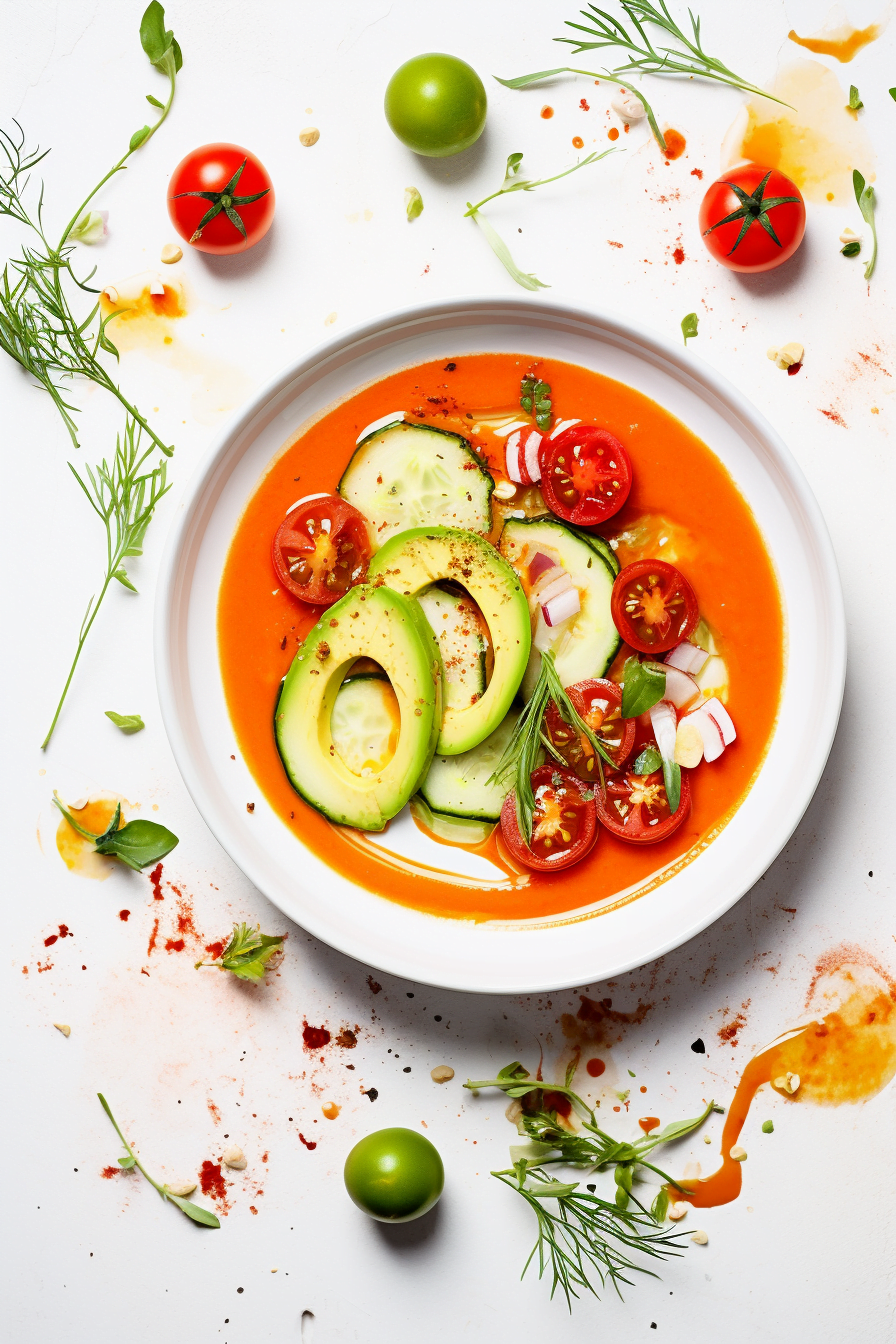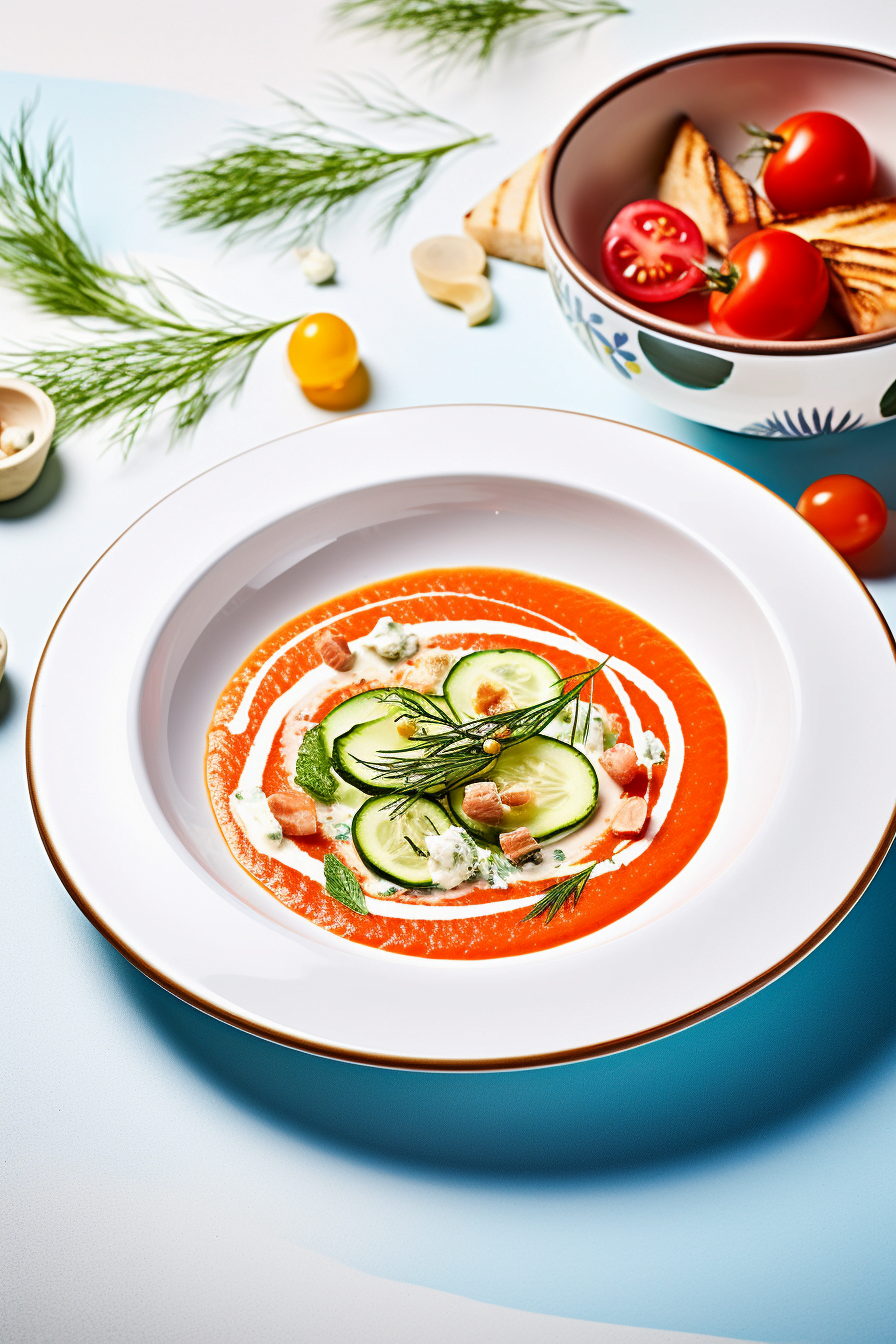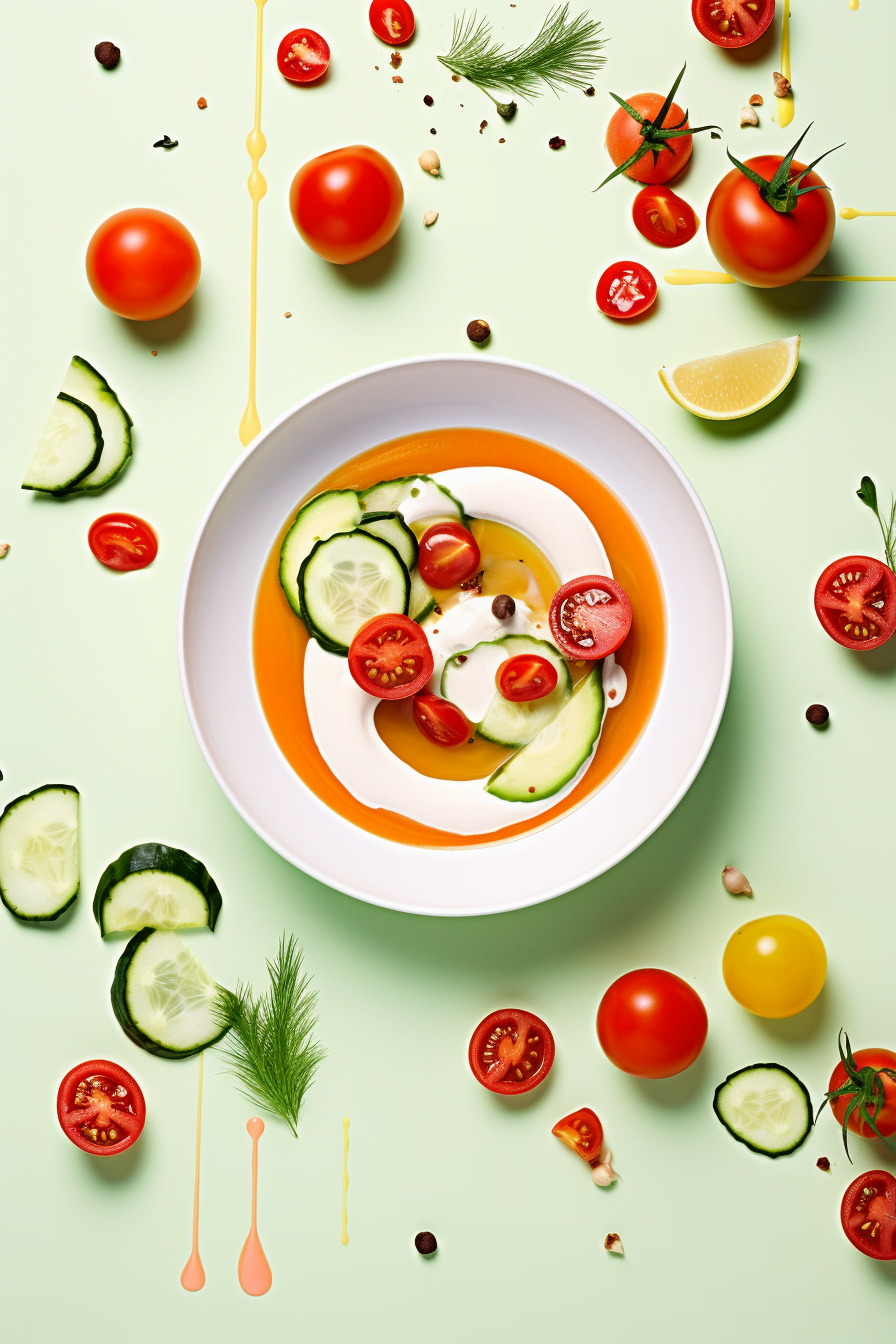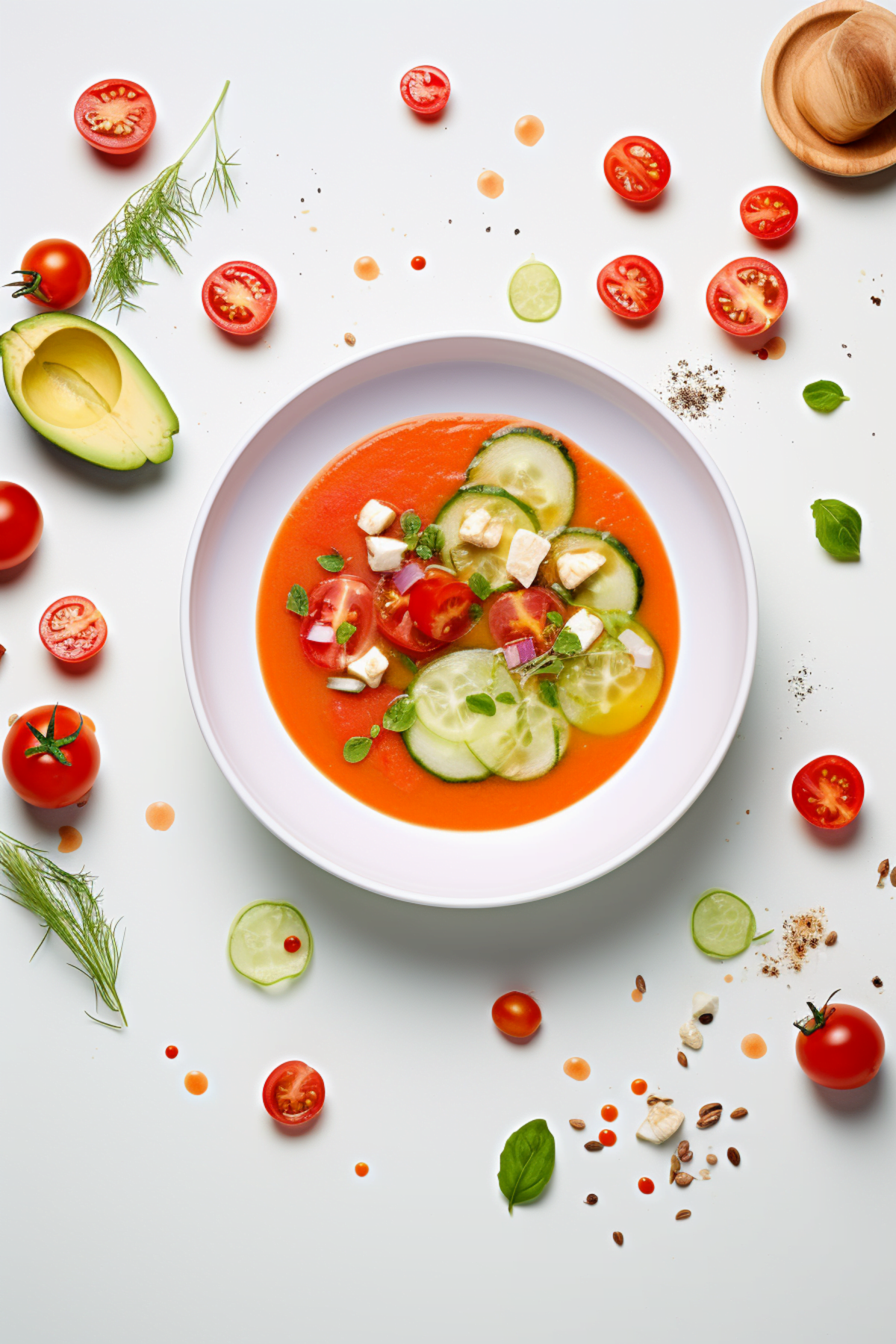Refreshing Tomato and Cucumber Gazpacho with Avocado and Dill
When the summer heat climbs, there’s nothing more refreshing than a bowl of Tomato and Cucumber Gazpacho with Avocado and Dill. This chilled soup is a vibrant celebration of Mediterranean flavors, offering a cool respite on the hottest of days. Not only is this gazpacho bursting with the fresh taste of ripe tomatoes and crisp cucumbers, but it also incorporates the creamy richness of avocado and the aromatic lift of dill. It’s a nutritious, no-cook meal that’s as easy to prepare as it is delightful to the palate.
Whether you’re looking for a light lunch, an elegant appetizer, or a simple dish to share at a summer gathering, this gazpacho is sure to impress. Read on to discover the inspiration behind this dish and learn how to create this simple yet sophisticated soup that epitomizes the essence of Mediterranean cuisine.

Origins and Inspirations of Gazpacho
Gazpacho is a dish with deep roots in the Mediterranean, specifically from the Andalusian region of Spain. Traditionally, it’s a tomato-based soup made from raw vegetables and served cold, making it ideal for the scorching Spanish summers. The version we’re exploring today, Tomato and Cucumber Gazpacho with Avocado and Dill, takes inspiration from this classic while introducing elements that are reminiscent of Greek cuisine, such as the use of dill and the inclusion of avocado for a creamy texture.
The beauty of gazpacho lies in its simplicity and versatility. It’s a dish that celebrates seasonal produce, and every region has its own take on this refreshing soup. The addition of avocado is a nod to the modern palate’s love for its buttery texture and healthy fats, while dill offers a hint of sharpness that complements the sweetness of ripe tomatoes. This recipe is a testament to the Mediterranean diet’s focus on fresh, whole foods and the art of combining them in ways that are both healthful and flavorful.
Each ingredient in this gazpacho has been chosen for its ability to stand out and harmonize with the others. The tomatoes provide the juicy base, cucumbers add crunch, and the red onions give a slight heat which is mellowed by the creamy avocado. Dill, while not traditionally Spanish, is often found in Mediterranean kitchens and brings a fresh, herby dimension that elevates the dish.
As a no-cook recipe, this gazpacho is also a celebration of raw cuisine, a concept that is gaining popularity for its nutritional benefits and ease of preparation. By blending together these raw ingredients, we create a soup that is not only packed with vitamins and antioxidants but also retains all the vibrant flavors of the vegetables.

Mastering the Method
The key to an exceptional gazpacho is in the quality of your ingredients and the balance of flavors. Start by selecting the ripest tomatoes you can find, as they will form the backbone of your soup. When it comes to blending, do so in batches to achieve a smooth consistency while still maintaining some texture from the vegetables.
**Blending Technique:** While the recipe calls for blending only half of the vegetable mixture, for those who prefer a smoother soup, you can blend all the vegetables together. However, retaining some chunks provides a delightful contrast and a more traditional feel. If you find the gazpacho too thick, add cold water sparingly to reach the perfect consistency without diluting the flavors.
**Chilling:** Gazpacho must be served cold, so chilling it for at least two hours before serving is crucial. This not only cools the soup but also allows the flavors to meld together beautifully. For an extra chill, serve with an ice cube in each bowl.
**Seasoning:** Don’t be shy with the seasoning. Gazpacho should be vibrant and well-seasoned. Taste and adjust with salt and freshly ground black pepper as needed. Remember, chilling can sometimes dull the flavors, so a final seasoning adjustment just before serving is a smart move.
**Garnish:** The garnish is not just for looks; it adds texture and flavor. The remaining diced avocado provides creaminess, and the extra dill offers a fresh herby note. Consider a drizzle of high-quality extra virgin olive oil or a few drops of balsamic vinegar for a final flourish.

Variation: Spicy Gazpacho
For those who enjoy a bit of heat, adding a small jalapeño or serrano pepper to the blend can transform this refreshing soup into a fiery delight. Remove the seeds to control the spice level, and blend it with the tomatoes for a well-distributed kick.
Variation: Fruit-Infused Gazpacho
Introduce a sweet twist by adding fruits like watermelon or strawberries. They pair wonderfully with the tomatoes and create a gazpacho that’s perfect for dessert or a sweet appetizer. Adjust the vinegar and seasoning to balance the sweetness.
Variation: Seafood Gazpacho
In coastal regions like the Costa del Sol, gazpacho is often served with seafood. Top your soup with fresh shrimp or lump crabmeat for a luxurious touch that makes it substantial enough for a main course.
Substitutions for Dietary Restrictions
If you’re accommodating dietary restrictions or simply missing an ingredient, fear not. Gazpacho is forgiving and adaptable.
**For a Low-FODMAP Diet:** Replace the red onion with the green tops of scallions to reduce the fructans that can cause discomfort for those with IBS.
**For a Nightshade-Free Version:** Omit the tomatoes and red bell pepper, and use carrots and golden beets instead. This will result in a sweeter gazpacho with a beautiful orange hue.
**For an Avocado Allergy:** Substitute avocado with soaked raw cashews or a dollop of Greek yogurt to maintain the creaminess without the avocado.
Frequently Asked Questions
Can I make gazpacho ahead of time?
Yes, gazpacho’s flavors improve with time. Make it a day in advance and store it in the refrigerator for an even tastier soup.
How long does gazpacho last in the fridge?
Properly stored in an airtight container, gazpacho can last up to 2 days in the fridge. Beyond that, the vegetables may start to lose their freshness.
Can gazpacho be frozen?
While you can freeze gazpacho, it may affect the texture. If you do freeze it, thaw it in the fridge and give it a good stir before serving.
Is gazpacho healthy?
Absolutely. Gazpacho is full of vitamins, minerals, and antioxidants. It’s a great way to enjoy a variety of fresh vegetables in one serving.
Can I use canned tomatoes for gazpacho?
Fresh tomatoes are ideal for the best flavor, but if they’re out of season, high-quality canned tomatoes can be used as a substitute.

Tomato and Cucumber Gazpacho with Avocado and Dill
Equipment
- Blender or food processor
- Mixing bowl
- Cutting board
- Chef's knife
- Measuring cups and spoons
Ingredients
- 1 pound ripe tomatoes roughly chopped
- 1 medium cucumber peeled and chopped
- 1 small red onion chopped
- 1 red bell pepper seeded and chopped
- 2 cloves garlic minced
- 1 ripe avocado pitted and diced
- 2 tablespoons extra virgin olive oil
- 2 tablespoons red wine vinegar
- 1/4 cup cold water or as needed
- 2 tablespoons fresh dill chopped, plus extra for garnish
- Salt and freshly ground black pepper to taste
- Ice cubes for serving optional
Instructions
- In a large mixing bowl, combine the chopped tomatoes, cucumber, red onion, and red bell pepper. Add the minced garlic to the mixture.
- Transfer half of the vegetable mixture to a blender or food processor. Add half of the diced avocado, olive oil, and red wine vinegar. Blend until smooth. If the mixture is too thick, add cold water one tablespoon at a time until the desired consistency is reached.
- Pour the blended mixture back into the bowl with the remaining chopped vegetables. Stir in the chopped dill, and season with salt and black pepper to taste. Mix well to combine all the flavors.
- Cover and refrigerate the gazpacho for at least 2 hours, or until well chilled.
- Before serving, stir the gazpacho well and do a final taste test, adjusting seasoning if necessary.
- Serve the gazpacho in chilled bowls or glasses, garnished with the remaining diced avocado and a sprinkle of fresh dill. For an extra cool touch, add an ice cube to each serving.
Notes

